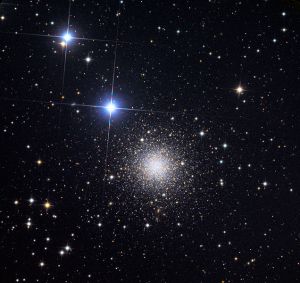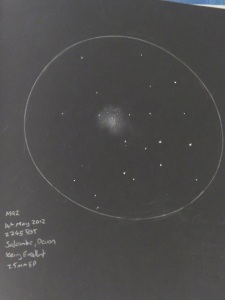It is such an uninspiring name.
Which is unfortunate as they are stunningly beautiful.
Globular Clusters.
Globs.
Sounds like something found on an X-ray.
But these are amazing little jewels. One of the most breath taking objects that can be framed in an eyepiece. In fact here is an object that looks better in an amatuer telescope than it does in the Hubble Space telescope.
I say little, M13 is 145 light years across and there in lies the beginning of the wonder. These objects are a very, very long way off.
The Hercules Globular Cluster or M13, is a group of about 300,000 stars and it sits over 25,000 light years from Earth. While part of the overall structure of the Milky Way, globular clusters are essentially satellites of the main spiral disc and in some respects can be thought of as mini galaxies.
At present 152 globs have been observed from a predicted 180, one of the furthest being NGC2419, which at 300,000 light years which for a while was not thought to be part of the Milky Way and so earned the nick name the ‘Intergalactic Wanderer’. But it is still part of our galaxy and takes an incredible 3 Billion years to make one trip around. At an estimated age of 12.3 billion years this fellow traveller has only completed four orbits.

They call me the wanderer…NGC2419, 300,000 light years away. (Adam Block/Mount Lemmon SkyCenter/University of Arizona)
12.3 billion years? These enigmatic objects are ancient. One of the closest, NGC6397 has been used to estimate the age of the Milky Way and the astronomers came back with a staggering 13.4 billion years for the age of the cluster. This makes it not much younger than the universe itself; when you are looking at a Globular Cluster you are witnessing one of the universes oldest artefacts.
Did I say close? NGC6397 is over 7,000 light years away. The light you see from it started out 3,000 years before the Egyptians threw up the Great Pyramid. But then the light from the Wanderer began it’s journey to your eye when evolution had yet to develop modern humans; such is the vast scale of the Milky Way.
So what are they? The simple answer is a ‘compact’ gravity bound grouping of stars. But this doesn’t answer the question of how or why? They are an ongoing mystery and are poorly understood, how they formed is still a major area of research and even the distances and ages are subject to quite large error margins. They contain fascinating oddities like ‘blue stragglers’ which are stars that may have been created by a collision of two stars. They may have a black hole at their core, or a group of neutron stars, or maybe a cluster of white dwarf stars. They are made up of population II stars in the main that appear to contain to few heavy elements to allow planetary formation, so while planets appear to be common here in the galactic disc, globs may well be planetary deserts.
Beautiful, secretive, distant and ancient. If you have never looked at one I guarantee you well get hooked when you do.
Shame about the name though.



